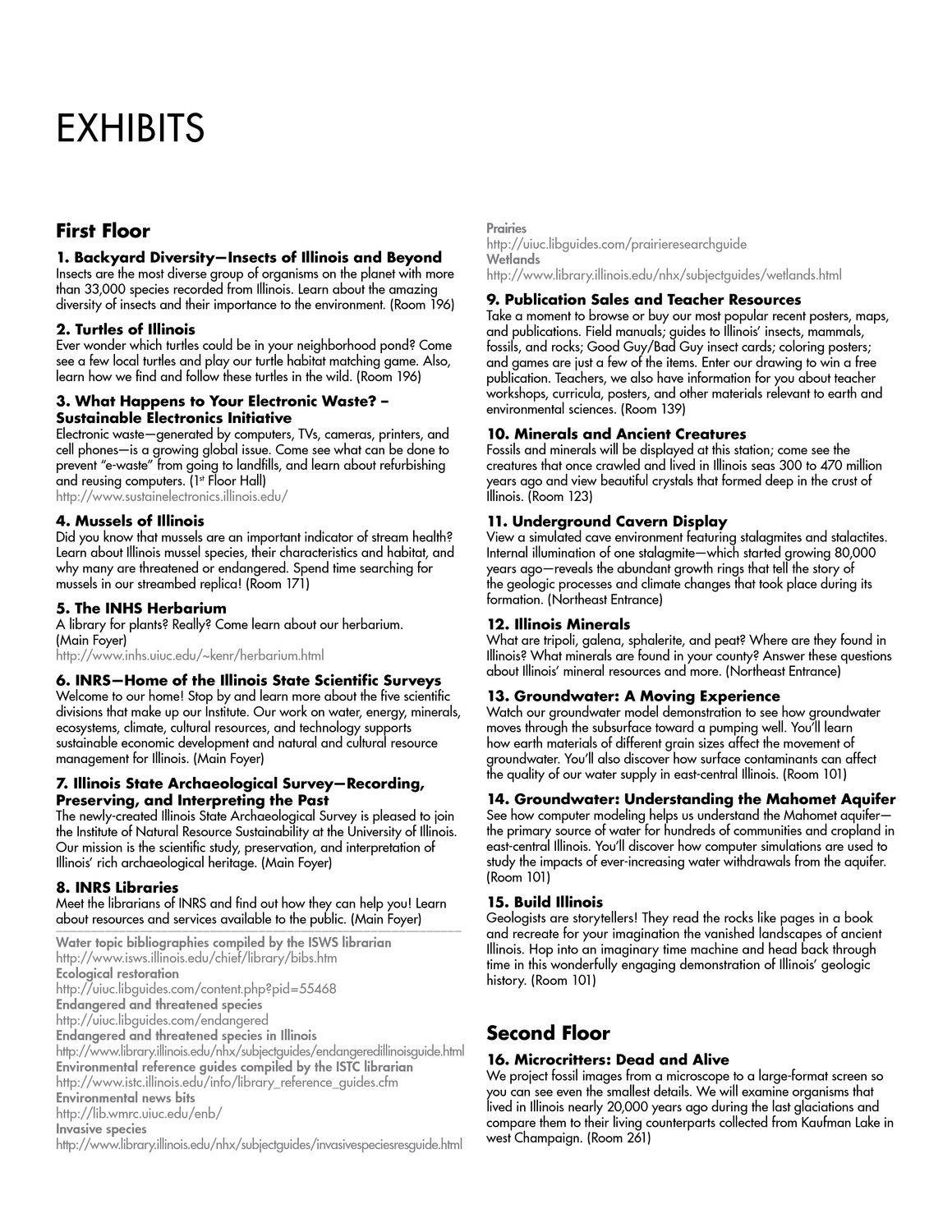Caption: IRNS Open House Guide - 2010
This is a reduced-resolution page image for fast online browsing.

EXTRACTED TEXT FROM PAGE:
ExHIBITS First Floor 1. Backyard diversity—insects of illinois and Beyond Insects are the most diverse group of organisms on the planet with more than 33,000 species recorded from Illinois. Learn about the amazing diversity of insects and their importance to the environment. (Room 196) Prairies http://uiuc.libguides.com/prairieresearchguide Wetlands http://www.library.illinois.edu/nhx/subjectguides/wetlands.html 9. Publication Sales and Teacher Resources 2. Turtles of illinois Ever wonder which turtles could be in your neighborhood pond? Come see a few local turtles and play our turtle habitat matching game. Also, learn how we find and follow these turtles in the wild. (Room 196) Electronic waste—generated by computers, TVs, cameras, printers, and cell phones—is a growing global issue. Come see what can be done to prevent “e-waste” from going to landfills, and learn about refurbishing and reusing computers. (1st Floor Hall) http://www.sustainelectronics.illinois.edu/ 3. What Happens to Your electronic Waste? – Sustainable electronics initiative Take a moment to browse or buy our most popular recent posters, maps, and publications. Field manuals; guides to Illinois’ insects, mammals, fossils, and rocks; Good Guy/Bad Guy insect cards; coloring posters; and games are just a few of the items. Enter our drawing to win a free publication. Teachers, we also have information for you about teacher workshops, curricula, posters, and other materials relevant to earth and environmental sciences. (Room 139) 10. Minerals and ancient Creatures Fossils and minerals will be displayed at this station; come see the creatures that once crawled and lived in Illinois seas 300 to 470 million years ago and view beautiful crystals that formed deep in the crust of Illinois. (Room 123) 4. Mussels of illinois Did you know that mussels are an important indicator of stream health? Learn about Illinois mussel species, their characteristics and habitat, and why many are threatened or endangered. Spend time searching for mussels in our streambed replica! (Room 171) 11. underground Cavern display 5. The inHS Herbarium View a simulated cave environment featuring stalagmites and stalactites. Internal illumination of one stalagmite—which started growing 80,000 years ago—reveals the abundant growth rings that tell the story of the geologic processes and climate changes that took place during its formation. (Northeast Entrance) A library for plants? Really? Come learn about our herbarium. (Main Foyer) http://www.inhs.uiuc.edu/~kenr/herbarium.html 12. illinois Minerals 6. inRS—Home of the illinois State Scientific Surveys What are tripoli, galena, sphalerite, and peat? Where are they found in Illinois? What minerals are found in your county? Answer these questions about Illinois’ mineral resources and more. (Northeast Entrance) Welcome to our home! Stop by and learn more about the five scientific divisions that make up our Institute. Our work on water, energy, minerals, ecosystems, climate, cultural resources, and technology supports sustainable economic development and natural and cultural resource management for Illinois. (Main Foyer) 13. groundwater: a Moving experience 7. illinois State archaeological Survey—Recording, Preserving, and interpreting the Past Watch our groundwater model demonstration to see how groundwater moves through the subsurface toward a pumping well. You’ll learn how earth materials of different grain sizes affect the movement of groundwater. You’ll also discover how surface contaminants can affect the quality of our water supply in east-central Illinois. (Room 101) The newly-created Illinois State Archaeological Survey is pleased to join the Institute of Natural Resource Sustainability at the University of Illinois. Our mission is the scientific study, preservation, and interpretation of Illinois’ rich archaeological heritage. (Main Foyer) 14. groundwater: understanding the Mahomet aquifer See how computer modeling helps us understand the Mahomet aquifer— the primary source of water for hundreds of communities and cropland in east-central Illinois. You’ll discover how computer simulations are used to study the impacts of ever-increasing water withdrawals from the aquifer. (Room 101) 8. inRS libraries Meet the librarians of INRS and find out how they can help you! Learn about resources and services available to the public. (Main Foyer) __________________________________________________________ Water topic bibliographies compiled by the ISWS librarian http://www.isws.illinois.edu/chief/library/bibs.htm Ecological restoration http://uiuc.libguides.com/content.php?pid=55468 Endangered and threatened species http://uiuc.libguides.com/endangered Endangered and threatened species in Illinois http://www.library.illinois.edu/nhx/subjectguides/endangeredillinoisguide.html Environmental reference guides compiled by the ISTC librarian http://www.istc.illinois.edu/info/library_reference_guides.cfm Environmental news bits http://lib.wmrc.uiuc.edu/enb/ Invasive species http://www.library.illinois.edu/nhx/subjectguides/invasivespeciesresguide.html 15. Build illinois Geologists are storytellers! They read the rocks like pages in a book and recreate for your imagination the vanished landscapes of ancient Illinois. Hop into an imaginary time machine and head back through time in this wonderfully engaging demonstration of Illinois’ geologic history. (Room 101) Second Floor 16. Microcritters: dead and alive We project fossil images from a microscope to a large-format screen so you can see even the smallest details. We will examine organisms that lived in Illinois nearly 20,000 years ago during the last glaciations and compare them to their living counterparts collected from Kaufman Lake in west Champaign. (Room 261)
|